Disclosure: This article contains affiliate links. We may earn a commission from purchases at no extra cost to you, which helps our travel content.
There comes a point in one's travels when the standard tourist experiences—however picturesque—simply won't suffice. After three decades of business trips to forty-odd countries, I've developed something of an allergy to the pedestrian. Bora Bora, with its postcard-perfect lagoon and honeymooner reputation, initially struck me as potentially falling into this category. How delightfully wrong I was. Beneath the veneer of infinity pools and overwater bungalows lies an adrenaline seeker's aquatic playground that rivals anything I've encountered from Singapore to Miami. While the average visitor contents themselves with basic snorkeling excursions, those willing to venture beyond the standard fare will discover that these electric blue waters offer far more exhilarating possibilities. Having just returned from a week of what I can only describe as calculated aquatic madness, I present to you twelve water adventures that will satisfy even the most jaded corporate escapee.
Jet Skiing the Volcanic Perimeter
There's something undeniably primal about circumnavigating an ancient volcano atop a 300-horsepower marine steed. Bora Bora's main island—the remnants of a collapsed volcanic caldera—creates a dramatic backdrop for what proved to be two hours of therapeutic high-velocity therapy.
I booked with Matira Jet Tours, operated by a former French naval officer named Philippe who approaches safety briefings with military precision while maintaining a distinctly Polynesian sense of adventure. The jet skis themselves are top-of-line Yamaha models, meticulously maintained and considerably more powerful than the rental fleet one typically encounters in places like Miami or Phuket.
The full-island circuit covers approximately 32 kilometers, allowing ample opportunity to open the throttle across vast stretches of open lagoon before navigating the narrower passages between motus (small islands). Philippe leads guests to several vantage points where Mount Otemanu and Mount Pahia reveal themselves from angles rarely seen in travel brochures—jagged, primordial formations that remind you this paradise was forged in volcanic violence.
The experience culminates at a remote sandbar accessible only during specific tidal conditions, where we paused for fresh coconut water and local insights from our guide. For those concerned about the environmental impact, I was pleased to discover the operation uses the newer four-stroke engines that significantly reduce emissions and underwater noise pollution.
For this excursion, my waterproof camera bag proved invaluable—a simple investment that allowed me to capture remarkable photos without risking my equipment to the elements.
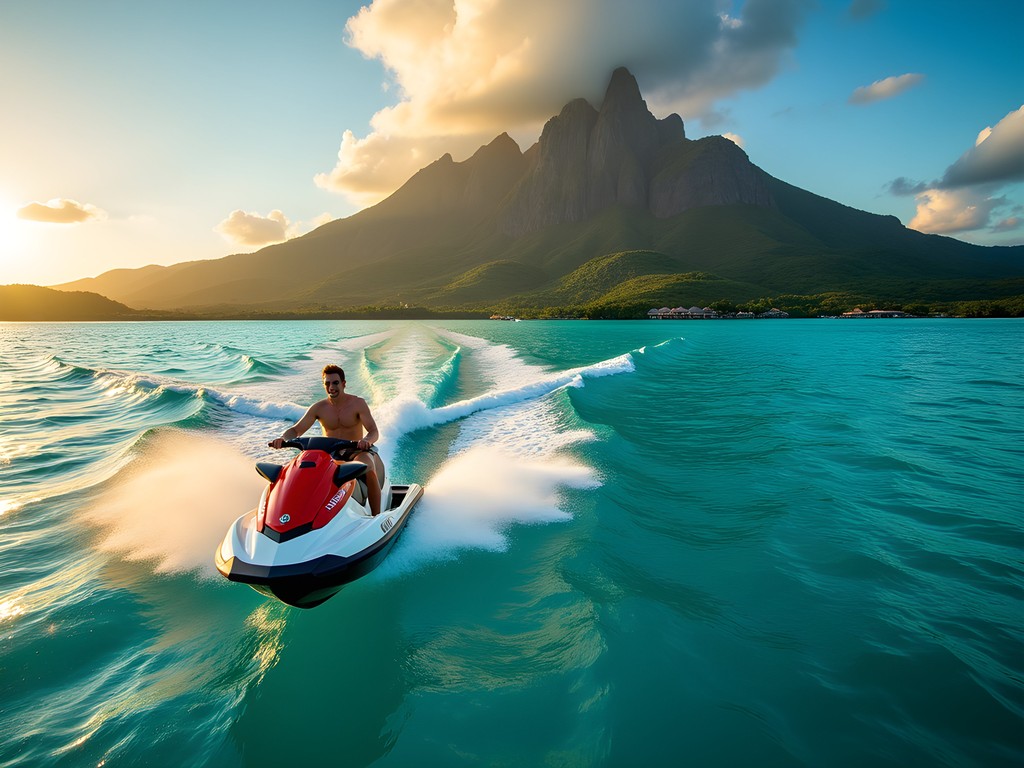
💡 Pro Tips
- Book the morning tour when winds are typically calmer and visibility is at its peak
- Wear a rash guard rather than just swimwear—the combination of sun and sea spray can be surprisingly harsh
- Request the extended tour that includes the outer reef passage—it's worth the premium for the dramatic wave action
Underwater Scooter Expeditions
For those seeking the thrill of underwater exploration without the technical requirements of scuba certification, Bora Bora's underwater scooter experience offers a compelling alternative. These personal submersibles—essentially underwater motorcycles with transparent bubble helmets—allow you to breathe normally while diving to depths of up to 10 meters.
I arranged my expedition through Aquabike Adventure, whose fleet of Seabob F5 S underwater scooters represents the pinnacle of personal submersible technology. The devices utilize an impeller propulsion system rather than traditional propellers, making them both safer for marine life and more efficient in the water.
After a surprisingly brief training session (the controls are remarkably intuitive), we descended into the legendary Coral Garden, a protected marine sanctuary on the western edge of the lagoon. The sensation is difficult to articulate—a curious blend of motorcycling and flying, but in three dimensions rather than two. One quickly develops a feel for the machine's responsiveness, learning to execute graceful arcs and dives through coral formations with minimal input.
What distinguishes this experience from conventional snorkeling or diving is the ground one can cover. In 90 minutes, we explored three distinct ecosystems: the shallow coral gardens, a deeper channel frequented by eagle rays, and finally, the edge of the outer reef where blacktip reef sharks patrol with military precision.
The guides communicate through an impressive series of hand signals, directing the group toward points of interest while ensuring everyone maintains appropriate depth and distance from delicate marine environments. For underwater visibility, I found my polarized swimming goggles performed admirably beneath the helmet, eliminating glare and enhancing color perception at depth.

💡 Pro Tips
- Eat lightly before the excursion—the sensation of underwater movement can trigger motion sensitivity in some participants
- Bring your own thin neoprene gloves for better grip on the controls
- Request the afternoon session when the black-tip reef sharks are most active near the coral gardens
Kite Foiling the Outer Lagoon
Having dabbled in kiteboarding across various global hotspots—from Cape Town's Table Bay to the windswept shores of Maui—I approached Bora Bora's kite foiling scene with measured expectations. Those expectations were summarily shattered within the first fifteen minutes on the water.
Kite foiling, for the uninitiated, combines traditional kiteboarding with hydrofoil technology, allowing the board to lift above the water's surface once sufficient speed is achieved. The result is a nearly frictionless glide that creates the uncanny sensation of flying above the lagoon rather than skimming across it.
Bora Bora's particular geography creates ideal conditions for this emerging sport. The consistent trade winds funnel between Mount Otemanu and the outer reef, generating reliable 15-25 knot breezes without the gusty conditions that plague many coastal locations. Meanwhile, the protected lagoon offers flat water conditions perfect for foiling, with sections deep enough to eliminate any concerns about the foil striking bottom.
I arranged three half-day sessions with KiteSurf Bora Bora, whose French-Polynesian instructors possess both technical expertise and intimate knowledge of the lagoon's microclimates. For experienced kiteboarders, they offer a foil conversion program that systematically builds the unique skills required for this discipline. Complete novices can opt for a traditional kiteboarding introduction before progressing to foil equipment.
The sensation of lifting above the water defies adequate description—a curious blend of wakeboarding, flying, and perhaps what I imagine surfing a cloud might feel like. Once foiling, the board generates virtually no spray or sound, creating an almost meditative experience as you glide silently above the kaleidoscopic reef patterns below.
For sun protection during extended sessions, I relied heavily on my reef-safe sunscreen, which maintained effectiveness despite hours of water immersion and perspiration.

💡 Pro Tips
- Book sessions for early morning when thermal winds haven't yet developed and conditions are most consistent
- Even experienced kiteboarders should take at least one transition lesson—foiling requires specific weight distribution techniques
- Bring neoprene booties as the launch area contains scattered coral fragments
Shark and Ray Feeding Dives
There exists a fine line between exhilaration and madness. Standing chest-deep in crystalline waters while blacktip reef sharks circle one's legs with increasing velocity certainly tests the boundaries of that distinction. Yet this is precisely the scenario I found myself in during what the locals casually refer to as a 'shark and ray ballet.'
Unlike many marine encounters globally that rely on chumming or artificial feeding patterns, Bora Bora's shark and ray experiences follow protocols developed in conjunction with marine biologists to minimize ecological impact. The feedings occur at specific locations where these interactions have naturally taken place for decades, with strict limitations on frequency and quantity of food introduced.
I arranged my excursion through Reef Discovery, whose Polynesian guides possess generational knowledge of the lagoon's ecosystem. Our small group departed via traditional outrigger canoe to a remote sandbar where the water transitions from knee to chest deep. After a thorough safety briefing (no sudden movements, no chasing the animals, hands kept above water unless instructed otherwise), our guide produced a modest container of fish scraps.
What followed can only be described as orchestrated chaos. Within minutes, we were surrounded by two dozen blacktip reef sharks—none longer than five feet but impressive nonetheless—and an equal number of stingrays whose wingspans often exceeded the height of our guide. The sharks maintained a respectful distance initially, content to circle our small human archipelago while the rays displayed no such restraint, their gelatinous bodies sliding against legs and torsos with unsettling familiarity.
Gradually, our guide demonstrated how to safely handle the rays, supporting their wings while avoiding the barbed tail. More remarkably, he eventually coaxed several sharks to take small morsels directly from his hand—a practice he's maintained for over fifteen years without incident.
For this aquatic ballet, I wore my quick-dry water shoes which provided essential grip on the sometimes slippery sand while protecting against occasional coral fragments.

💡 Pro Tips
- Choose operators who follow the Polynesian Marine Conservation Charter, limiting group sizes and feeding quantities
- Wear polarized sunglasses to better track shark movements in the water
- Remove jewelry before entering the water as the reflective surfaces can be mistaken for fish scales
Parasailing the Volcanic Caldera
There's a particular perspective of Bora Bora that remains inaccessible to most visitors—the aerial view typically reserved for arriving and departing aircraft. Parasailing offers a rare opportunity to witness the full geological drama of this ancient volcanic caldera from above, while experiencing the peculiar sensation of silent flight.
Unlike parasailing operations I've encountered elsewhere, Bora Bora's outfitters have refined the experience to eliminate the ungraceful beach launches and water dragging that often characterize the activity. Instead, Vaitape Parasailing utilizes a purpose-built platform boat with a hydraulic launch and recovery system that allows participants to begin and end their flight completely dry—departing from and returning to a comfortable seated position.
The ascent is remarkably swift yet smooth, with the canopy quickly finding stable air at approximately 150 meters above the lagoon. What follows is twelve minutes of profound silence interrupted only by occasional wind shifts and the distant hum of the boat below. From this elevation, the full complexity of Bora Bora's reef system reveals itself—concentric rings of varying depths creating a topographic map of blues ranging from cobalt to turquoise.
Most striking is the perfect volcanic crescent of motus (islets) forming the outer ring of the atoll, their palm-fringed edges creating a natural barrier between the tranquil lagoon and the deep Pacific beyond. Mount Otemanu and Mount Pahia dominate the center, their jagged profiles testament to the violent geological forces that created this paradise.
While many parasailing experiences globally last barely five minutes, the Bora Bora operators have recognized the contemplative value of extended flight time, with standard packages offering 12-15 minutes aloft—sufficient time to complete a full circumnavigation of the main island.
For capturing the aerial perspective, my action camera with its wide-angle lens proved ideal, securely fastened to a chest mount to allow hands-free operation while airborne.

💡 Pro Tips
- Request the first morning slot when winds are typically lightest and visibility optimal
- Specify a 'no dip' experience if you prefer to stay dry throughout the flight
- Bring a radio-controlled selfie stick for your camera—the height makes standard arm-length selfies less effective
Deep Sea Fishing the Outer Banks
There's something primally satisfying about pursuing pelagic giants in waters where the ocean floor drops away to unfathomable depths. Just beyond Bora Bora's protective reef lies the open Pacific, where currents converging around the Society Islands create a marine highway for some of the ocean's most formidable predators.
After sampling the standard tourist fare for several days, I found myself craving something more substantial. A chance conversation with a local boat captain at the St. Regis bar led to an impromptu booking with Moana Adventure Tours for a full-day expedition targeting yellowfin tuna, mahi-mahi, and the occasional marlin that patrol these waters.
We departed well before sunrise from the main harbor, the twin outboards pushing us through the reef pass as first light revealed the dramatic silhouette of Mount Otemanu behind us. Captain Tehotu, a third-generation fisherman whose family has worked these waters since the 1950s, navigated with the confident precision that comes only from intimate knowledge of local conditions.
The operation runs with remarkable efficiency—four outrigger lines deployed in staggered formation, each rigged with lures specifically designed for Polynesian conditions. These aren't the garish plastic contraptions favored in tourist operations elsewhere, but hand-crafted wooden plugs whose action mimics the panicked movement of flying fish, the preferred prey of yellowfin tuna in these waters.
Three hours and several false alarms later, the starboard outrigger released with a mechanical snap that sent adrenaline coursing through the boat. What followed was forty minutes of genuinely challenging physical exertion as a 70kg yellowfin tuna tested both equipment and resolve. The fish executed multiple blistering runs, each stripping hundreds of meters of line before I could begin the laborious process of recovery.
When finally brought alongside, the fish displayed that metallic iridescence unique to yellowfin—electric blues and yellows that seem almost artificial in their intensity. After documenting the catch, we released the magnificent creature back to the deep, adhering to the sustainable fishing practices that have become standard among reputable operators in French Polynesia.
For this expedition, my polarized fishing sunglasses proved invaluable, eliminating surface glare and allowing me to track the fish during its final approach to the boat.

💡 Pro Tips
- Book with operators who practice tag-and-release for billfish species
- Request departure times that coincide with tidal changes when pelagic species are most active
- Bring fingerless fishing gloves to prevent line burns during extended fights
Final Thoughts
As my seaplane banked sharply over Mount Otemanu on departure, I found myself reflecting on how thoroughly Bora Bora had dismantled my preconceptions. Far from being merely a honeymooner's haven of overwater bungalows and sunset cocktails, this ancient volcano cradles an aquatic playground of remarkable diversity. The true magic of Bora Bora reveals itself not to those content with passive observation, but to travelers willing to engage with its waters in more demanding ways. Whether you're slicing through the lagoon on a hydrofoil, coming face-to-face with its apex predators, or witnessing its geological majesty from 150 meters aloft, Bora Bora rewards the adventurous in ways that transcend the standard tropical narrative. The island has rightfully earned its place alongside Singapore and Tokyo in my regular rotation of destinations that successfully blend luxury accommodations with genuine adventure opportunities. For those willing to venture beyond the infinity pool, Bora Bora's waters offer transformative experiences that will recalibrate your understanding of what a South Pacific holiday can be.
✨ Key Takeaways
- Bora Bora offers far more than the standard honeymoon experience for adventure seekers
- The unique geography creates ideal conditions for both motorized and wind-powered water sports
- Responsible marine wildlife encounters provide safe yet exhilarating interactions
- The combination of luxury accommodations and extreme sports creates a perfect balance for discerning travelers
📋 Practical Information
Best Time to Visit
May through October (dry season)
Budget Estimate
$800-1,200 USD per day including luxury accommodation
Recommended Duration
7-10 days
Difficulty Level
Moderate To Challenging
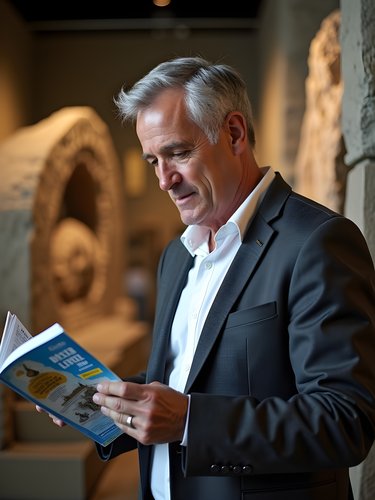

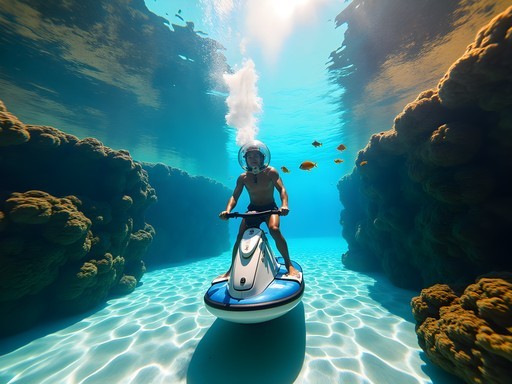






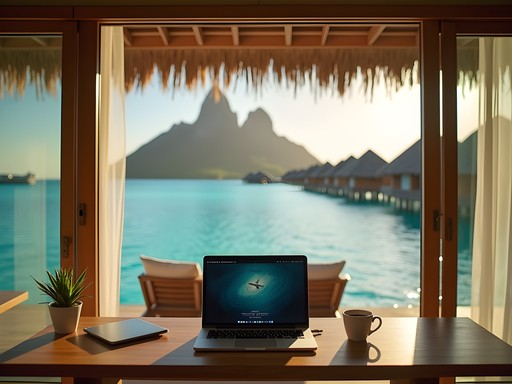

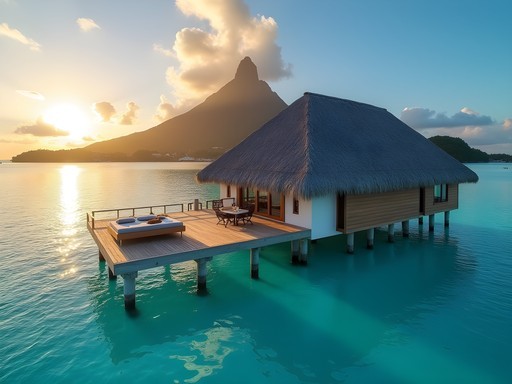
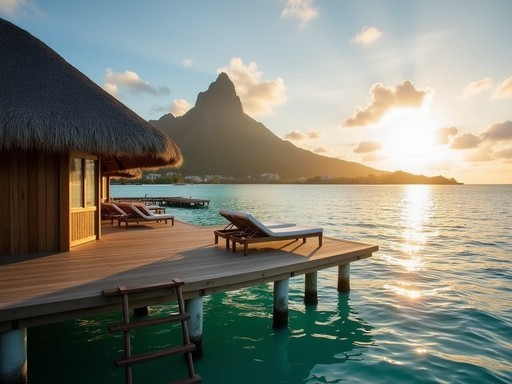




Comments
sunnyadventurer
Has anyone tried the night diving option mentioned? Wondering if it's worth the extra cost or if daytime diving gives you pretty much the same experience?
Jean Wells
The night diving reveals a completely different ecosystem - sleeping parrotfish, hunting lionfish, and bioluminescent organisms. It's an entirely different experience, well worth the premium if you're comfortable with reduced visibility.
sunnyadventurer
Thanks Jean! Sounds like I need to budget for both experiences then!
coffeeking
Those underwater scooter pics are insane! Definitely on my bucket list now.
Jean Wells
Having visited Bora Bora five times over the past decade, I appreciate your focus on activities beyond the standard tourist fare. The volcanic perimeter jet ski tour offers fascinating geological insights that most visitors miss. I'd add that timing is crucial - the morning light creates dramatic shadows on Mount Otemanu's western face, perfect for photography enthusiasts. For underwater visibility, I've found September-October optimal, with 30+ meter clarity for those shark dives. One recommendation: consider bringing your own underwater camera as rental equipment quality varies significantly between operators.
coffeeking
Jean, did you feel safe during the shark feeding? I'm terrified of sharks but really want to try it!
Jean Wells
Perfectly safe with reputable operators. The blacktip reef sharks are accustomed to these feedings and show little interest in humans. Start with an observation from slightly further back if you're nervous - you can always move closer as your comfort increases.
exploreseeker
Just got back from Bora Bora last month and did the shark feeding dive you mentioned! Absolutely terrifying and exhilarating at the same time. Our guide Teva was incredible - made us feel safe while still getting so close to those blacktip reef sharks. The colors under the water were unreal. Wish I'd known about the underwater scooter though, that sounds amazing!
backpackblogger
Great post Kyle! How difficult would you say the kite foiling is for someone who's never done it before? Planning my first Bora Bora trip and wondering if I should attempt it or stick to the underwater scooter.
Kyle Franklin
Thanks for asking! I'd recommend starting with the underwater scooter - much easier learning curve. Kite foiling requires at least 2-3 days of lessons if you're a complete beginner. The lagoon has some great instructors though if you're up for the challenge!
backpackblogger
Perfect, thanks! Will definitely try the scooter first then.
Kimberly Murphy
Brilliant article Kyle! I led adventure tours in French Polynesia for years and Bora Bora's water activities are truly unmatched. For anyone planning a trip, I'd add parasailing to this list - the views of the lagoon's color gradient from above are mind-blowing. One important tip: the UV index is extreme here, so proper sun protection is crucial. I've seen too many adventures cut short by severe sunburn. Also, if you're doing multiple water activities, consider bringing your own rash guard rather than renting - more hygienic and usually better quality. The shark feeding is perfectly safe but definitely book with established operators who practice responsible wildlife interaction.
oceantime
Thanks for the parasailing tip! Adding that to my itinerary for sure!
wavevibes
Stunning photos! Bora Bora has been on my list forever.
Casey Andersson
What a refreshing take on Bora Bora! Everyone thinks it's just honeymoon overwater bungalows and lazy snorkeling (which is lovely too), but you've captured the adventurous side perfectly. I'd add parasailing to your list - soaring 300 feet above that famous lagoon gives you a perspective that even drone photos can't capture. The color gradients of turquoise to deep blue are mesmerizing from up there. My husband was terrified but even he admits it was worth it! One caution about the jet skiing - if you go during December-February like we did, afternoon thunderstorms can roll in quickly, so morning tours are safer bets.
starmaster
Casey - did you need to book the parasailing in advance or can you just walk up?
Casey Andersson
We booked 2 days ahead through our resort, but I saw people booking same-day too. Just depends on the season - we went during peak time in January.
explorehero
Just got back from Bora Bora last week and tried the jet skiing around the island! Absolutely incredible experience but definitely more challenging than I expected when the water gets choppy. Make sure to book early in your trip in case weather causes cancellations - we almost missed out. The views of the mountain from the water are unreal though. Worth every penny!
oceantime
OMG those underwater scooters look AMAZING!! 😍 Did anyone feel claustrophobic with the helmet setup??
Kyle Franklin
Great question! The helmets are surprisingly comfortable and well-ventilated. The guides do a thorough orientation to help anyone with initial anxiety.
Venture X
Premium card with 2X miles, $300 travel credit, Priority Pass